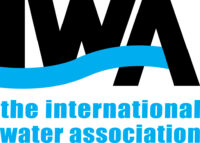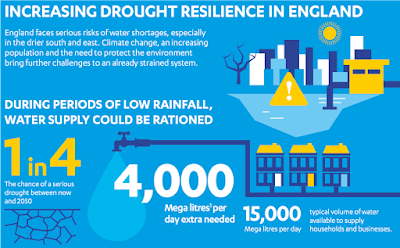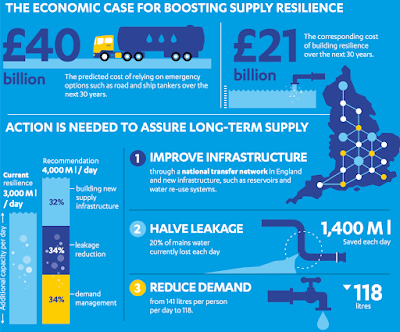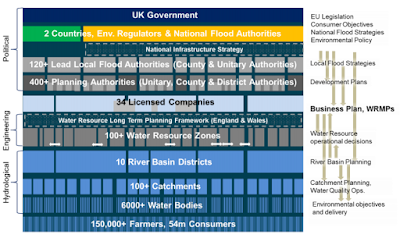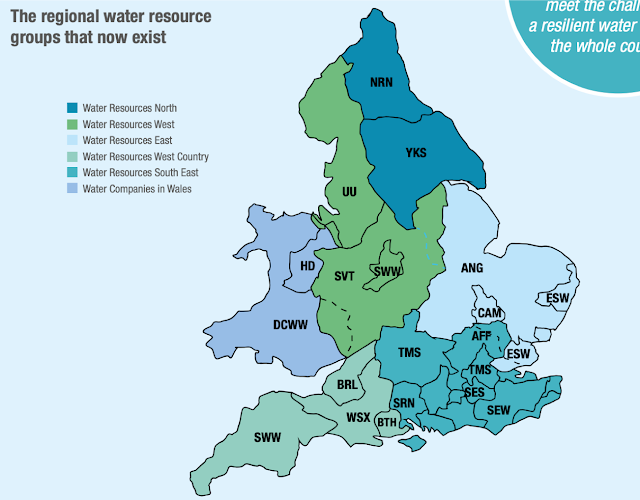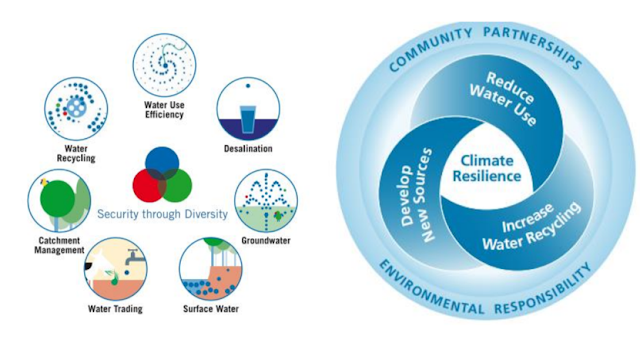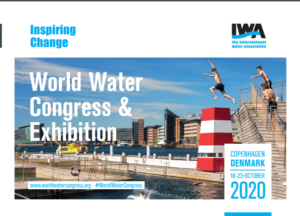I was recently asked to present on the current and future challenges for a water resources manager to address. We have seen a great deal of change and progress in how we plan for water resources in England over the last decade. This blog post summarises some of the key challenges I highlighted in my presentation.
Join the discussion as part of Theme 6 on Water Resources and Large Scale Water Management at the IWA World Water Congress in Copenhagen (October 2020 – see call for papers here).
PRESSURES ON WATER RESOURCES
We face increasing pressures on water resources from climate change, population growth and the need to protect the environment. The latest summary of these pressures has been provided by the National Infrastructure Commission’s 2018 report Preparing for a drier future: England’s water infrastructure needs. This sets out a 1 in 4 chance of serious drought between now and 2050 and that emergency options to address this could cost £40 billion vs £21 billion by taking a strategic approach. The Water UK Long Term Water Resource Planning Framework also highlights that there is an increasing risk of more frequent and intense droughts across England and Wales, not just in the South East.
CURRENT CHALLENGES
Regulatory complexity and planning
We face a complicated policy and regulatory landscape when it comes to management of water resources. This is summarised by the figure below from Ofwat’s Water 2020 report and since its publications there are further government policies linked to the 25 Year Environment Plan (e.g. biodiversity net gain) and new plans such as Drainage and Wastewater Management Plans that will have implications going forward for water resources management. Water companies face many tensions around meeting the objectives of Defra, Ofwat, the Environment Agency, CCWater and other government bodies. Additionally, the timeframes for planning are still not aligned.
In the latest planning period there has been greater consideration of the links between drought planning and long-term water resources management plans (WRMPs). An increasing level of complexity has been introduced into the water resources planning process. This is set out in the 2016 UWKIR report WRMP 2019 Methods – Decision Making Process: Guidance. Taking a risk based approach enables selection of the most appropriate methods for individual water companies. However, many of the more advanced processes may be less transparent and can be hard to communicate to customers and wider stakeholders. We need to keep sight of outputs and visualisations as decision making tools for planners and stakeholders to engage with, not as the ultimate output themselves. This was an issue I commented on in a blog post in 2016 when the WRMP guidance was published.
Resilience
Resilience to climate change and drought is a major factor in water resources planning. However, increasingly we are seeing the need for wider resilience to be addressed around changes to peak demand linked to hot weather. June 2018 was the driest June since 1925, with a rainfall total for England of only 15 mm. In England, United Utilities applied for a hosepipe ban, then called it off. In Northern Ireland a hosepipe ban was implemented for three weeks. In Scotland, the sustained dry weather and heatwave conditions in 2018 resulted in less water availability and an increase in customer demand. In some areas this was an additional 30% of demand and led to Scottish Water producing an additional 140Ml/d (Water Efficiency Strategy for the UK Year 1 Report).
The freeze-thaw incident of March 2018 resulted in more than 20,000 homes in London being without water due to pipe bursts and the wider impacts across the network of this increase in water demand. Many of the issues faced in terms of planning and customer engagement were similar to those that have been experience during times of drought. I wrote about this in a blog post for the WATEF network. What this incident highlighted was that many of the customer engagement lessons and recommendations from the 2012 drought had still not been implemented.
Competition and markets
In May 2019 Ofwat wrote to incumbent water companies and highlighted their desire to see development of more effective markets. These include developer services (e.g. self-lay networks), upstream water resources options and working with water retail companies who now supply non-household customers. Although water companies have released detailed information on their water resources requirements with their WRMPs there has been very little uptake by third party providers. Ofwat recently consulted on this “bilateral market” for water resources. Although we have had new appointments and variations for some time now, where an alternative water company to the incumbent can supply to a new development, this hasn’t been as successful as in New South Wales in Australia where a similar regulatory regime has enabled new semi-autonomous water schemes within Sydney (see previous blog post).
One of the benefits of moving to retail competition for non-household customers identified in the Cave Review (2009) and the Water Act 2014 was greater levels of water efficiency. Research (link to report) early in the first year of market opening observed a limited range of services being offered. Ofwat’s report on year 2 of the market highlights that “water efficiency measures has been slow to
develop”:
- Around 0.3% of customers who switched since market opening report leakage control services as a benefit of switching
- Only 4% of customers who had renegotiated since market opening report water efficiency services as a benefit of renegotiating
- “on the basis of customer interest and in view of a number of possible barriers to take up, that there remains untapped potential for continued development in the offer and take up of water efficiency services”
Regional water resources planning
In the lead up to WRMP24 a National Water Resources Framework group and further regional water planning bodies have evolved. Their aim is to (link to WRSE newsletter):
- Develop strategic plans that set out each region’s contribution to the national need
- Deliver ‘nationwide’ resilience – and greater ambition on metering, leakage, and options to lower demand and new transfers flagged as necessary by the National Infrastructure Commission (NIC)
- Enable greater collaboration through more consistent planning approaches and by identifying and removing existing barriers.
FUTURE CHALLENGES
Abstraction licence changes and catchment management
Abstraction licence reform is progressing with pilot catchments and a bottom-up focus rather than the legislative changes that have been proposed previously. By 2021 the programme aims for (see presentation at CIWEM Water Resources Conference 2018):
- 90% of surface water bodies and 77% of groundwater bodies at the required standards
- RSA programme completed
- 2,300 time limited licences reviewed
- 10 licensing strategies detail solutions for the most affected catchments (all updated by 2027)
- Solutions to remaining environmental pressures
- Improving access to water
- A new and consistent regulatory regime and a modern service
- Clearer access to vital data (such as flows and licence details)
- Simpler processes
Demand management
Water efficiency
With common performance commitments as part of Ofwat’s PR19 business planning process on water use, leakage and drought resilience there should be a greater business focus on demand management than in the past. The NIC report suggests 34% of the resilience gap can be met by demand management. However, this focusses on metering alone and there are still large savings that can be made through produce labelling, building standards and behaviour change programmes.
Defra are consulting on a range of measures including personals water consumption targets, incentives and smart metering. Water efficiency labelling combined with product standards and building regulations could reduce consumption by 30 litres per person per day within 25 years. Additionally, water companies need to engage with customers on climate change and population growth issues linked to rising consumption and to support working with them individually to help meet PCC targets. Smart metering is a key tool to provide the feedback on consumption to enable individual targets to support water company wide reduction in water consumption.
A recent experience of implementing water use percentage reduction targets can be seen in California. A report “Making Water Conservation a California Way of Life” identified that targets resulted in a 33% reduction in water use (Gallons per customer per day – equivalent to PCC).
Leakage
An average target for leakage reduction of 17% by the end of 2020-25 across all companies in England and Wales has been reported for PR19 draft determinations. This represents a significant challenge around technology and innovation to achieve this reduction, especially when the total reduction achieved in the last year was just 0.4% (Figures from WWT Databank, Vol 62, Issue 9). This is a major area of collaborative research focus in the UK via UKWIR with their strategic question “How will we achieve zero leakage by 2050 in a sustainable way?“.
Transitions for resilience
A new approach will be needed to support resilience to climate change, the wider pressures of population growth and the need to protect the environment. A successful approach to this has been applied in Western Australia using a security through diversity model. CIWEM’s 2018 position on planning water resources recommends “Adoption of a ‘security through diversity’ approach to managing water resources”:
Links with business planning and customer outcomes
Increasing engagement will be required when developing plans and considering options (as has been the case across the last several price reviews). Water resources options, especially those based on demand management or integrated water management can have large impacts on CMeX and DMeX . Water companies will need to work across the business to deliver performance commitments and Water UK work on public interest.
CONCLUSIONS
I’ve outlined above some of the current and future pressures faced by water resources managers in England.
- We are facing increasing pressures on water resources
- There is increasing complexity of water resources planning and regional engagement
- Transitions are required for resilient water supplies and wider sustainable water management (addressing flooding, water quality etc.)
- These challenges are opportunities to improve outcomes for customers, the environment and business
Moving into PR24 there will be greater room for innovation in planning and delivering water resources as part of the wider social contract between water companies and customers. Water is a key medium through which we feel the impacts of climate change and recent declarations of a climate emergency need to take better account of this.
JOIN THE DISCUSSION AT IWA WORLD WATER CONGRESS 2020
Groundwater
- Groundwater mapping, monitoring and modelling
- Protection of groundwater quality and quantity
- Soil contamination and groundwater remediation
- Governance, management and institutional arrangements
Surface Water
- Surface water monitoring systems and models
- Protection of surface water quality and quantity
- Source-to-sea pollution management
- Pollution from point sources – agriculture, industry, urban
- Diffuse pollution – sources and mitigation
- Water-related ecosystems and environmental flows
Integrated Water Resources Management
- Water stress, droughts and floods, including impact of climate change
- Catchment management and ecosystem services on different scales
- Large-scale nature-based solutions and biodiversity
- Water rights, trading and partnerships
Holistic Assessments
- Life cycle assessment, water efficiency, water footprint, virtual water, etc.
- Planetary boundaries and science of sustainability
- Water resource management towards Sustainable Development Goals (SDGs)
Find out more at: https://worldwatercongress.org/
